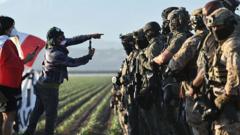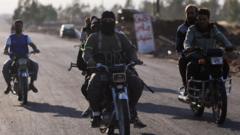The assault further strains relations as Iran vows to respond, igniting regional instability.
**U.S. Strikes Intensify Tensions with Iran Amid Ongoing Conflict**

**U.S. Strikes Intensify Tensions with Iran Amid Ongoing Conflict**
U.S. military action against Iranian nuclear facilities amplifies fears of wider escalation in the Middle East.
June 22, 2025 - Tensions reached a new peak today as the Pentagon confirmed substantial damage to three key Iranian nuclear sites following U.S. airstrikes ordered by President Trump. Officials stated that while the exact impact of the attacks was still being assessed, it was too early to determine whether Iran retained any significant nuclear capability. In a stark response, Iranian authorities reacted with outrage, promising to defend against what they termed as "criminal aggression."
The strikes, executed under the name "Operation Midnight Hammer," targeted both the Fordo and Natanz nuclear facilities, which have been central to Tehran's uranium enrichment efforts. Pentagon spokespersons described the operations as successful yet noted the complexities involved in fully securing these high-value military targets. Intelligence assessments reveal that while some capacity had been disabled, the ultimate effectiveness of these strikes might remain uncertain.
Iran’s Foreign Minister, Abbas Araghchi, rebuked the U.S. for undermining recent diplomatic dialogues, asserting that Iran is prepared to take any actions necessary to safeguard its national interests. "No country can simply invade and expect to escape repercussions," he stated, hinting at possible retaliatory measures against U.S. forces in the region and asserting Tehran’s right to self-defense.
In an alarming development, Iranian air defenses reportedly did not engage U.S. bombers during the strike—a stark indication of their vulnerability. Following the assault, Iran launched missiles targeting various locations within Israel, marking a significant escalation in hostilities. Israel confirmed injuries and damage from the Iranian attacks, further complicating the fragile regional security landscape.
As international reactions unfold, political analysts predict a complicated aftermath. With over 40,000 U.S. troops stationed across the Middle East, the threat of retaliation against these forces looms, potentially dragging the U.S. deeper into an escalating conflict. Experts note that while deterrence remains a priority for both nations, Iran’s military capabilities, including ballistic missile technology, continue to pose a daunting challenge.
With eyes on the possibility of renewed negotiations, the upcoming days will hinge on both nations' responses and the potential for dialogue amidst rising aggression. Military analysts suggest that a measured approach could open avenues for diplomatic resolutions, while a more aggressive Iranian response could lead to increased military engagements.
The dynamics suggest an inflection point, with implications that reverberate far beyond the immediate conflict, reshaping alliances and strategies in a volatile region.
The strikes, executed under the name "Operation Midnight Hammer," targeted both the Fordo and Natanz nuclear facilities, which have been central to Tehran's uranium enrichment efforts. Pentagon spokespersons described the operations as successful yet noted the complexities involved in fully securing these high-value military targets. Intelligence assessments reveal that while some capacity had been disabled, the ultimate effectiveness of these strikes might remain uncertain.
Iran’s Foreign Minister, Abbas Araghchi, rebuked the U.S. for undermining recent diplomatic dialogues, asserting that Iran is prepared to take any actions necessary to safeguard its national interests. "No country can simply invade and expect to escape repercussions," he stated, hinting at possible retaliatory measures against U.S. forces in the region and asserting Tehran’s right to self-defense.
In an alarming development, Iranian air defenses reportedly did not engage U.S. bombers during the strike—a stark indication of their vulnerability. Following the assault, Iran launched missiles targeting various locations within Israel, marking a significant escalation in hostilities. Israel confirmed injuries and damage from the Iranian attacks, further complicating the fragile regional security landscape.
As international reactions unfold, political analysts predict a complicated aftermath. With over 40,000 U.S. troops stationed across the Middle East, the threat of retaliation against these forces looms, potentially dragging the U.S. deeper into an escalating conflict. Experts note that while deterrence remains a priority for both nations, Iran’s military capabilities, including ballistic missile technology, continue to pose a daunting challenge.
With eyes on the possibility of renewed negotiations, the upcoming days will hinge on both nations' responses and the potential for dialogue amidst rising aggression. Military analysts suggest that a measured approach could open avenues for diplomatic resolutions, while a more aggressive Iranian response could lead to increased military engagements.
The dynamics suggest an inflection point, with implications that reverberate far beyond the immediate conflict, reshaping alliances and strategies in a volatile region.





















